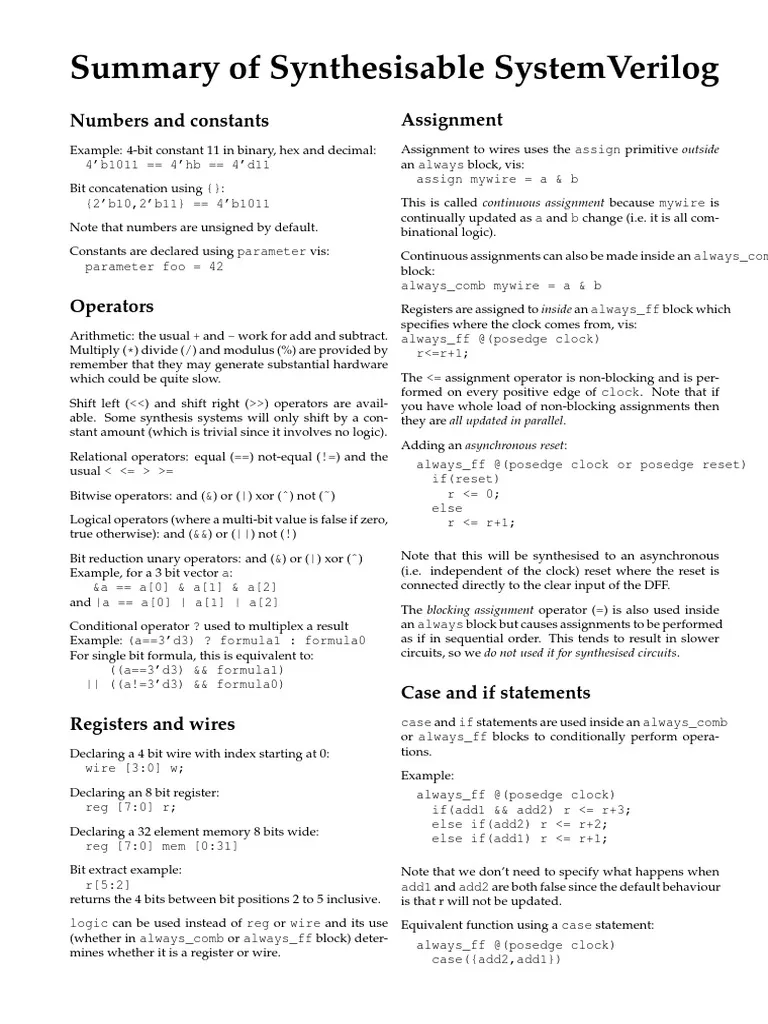Verilog Syntax Cheat Sheet - Data Formats: - Standard Syntax: WIDTH'BASEVALUE - Example: 16'ha; - 16 bit field, value of 0x000a - Bases: d = decimal, b.
| library ieee; |
| use ieee.std_logic_1164.all; |
| use ieee.numeric_std.all; |
| use ieee.std_logic_unsigned.all; |
| -- interface |
| entitymy_entityis |
| generic( |
| ); |
| port( |
| in_port : instd_logic; |
| out_port : outstd_logic; |
| bidir: inoutstd_logic_vector(7downto0) =: (others=>'0') |
| ); |
| end[entrity] [my_entity]; |
| -- implementation |
| architecturertlofmy_entityis |
| -- local/internal signal |
| signal counter: std_logic_vector(10downto0) := (others=>'0'); |
| -- imports 'my_cmp' (entity) into architecture |
| componentmy_cmp |
| port( |
| a : instd_logic; |
| c : outstd_logic |
| ); |
| endcomponent; |
| begin |
| -- instantiate component |
| myCmp: my_cmp |
| -- map: component port => signal |
| portmap( |
| a => in_port, |
| c => out_port |
| ); |
| -- clocked (sync) |
| process(clk) |
| begin |
| ifrising_edge(clk) then |
| counter <= counter +1; |
| endif; |
| endprocess; |
| -- combinatorial (async) |
| out_port <= count; |
| end[architecture] [rtl]; |
Vhdl Code Examples
- The VHDL Golden Reference Guide is a compact quick reference guide to the VHDL language, its syntax, semantics, synthesis and application to hardware design. The VHDL Golden Reference Guide is not intended as a replacement for the IEEE Standard VHDL Language Reference Manual. Unlike that document, the Golden Reference guide does not offer a.
- GitHub - ismailelbadawy/vhdl-cheat-sheet: This is a cheat sheet for vhdl to help when in doubt about syntax or buidling blocks.
A test bench is required to verify the functionality of complex modules in VHDL. This posts contain information about how to write testbenches to get you started right away.
Vhdl Syntax Cheat Sheet Excel
Common Constructs for a test bench


wait statement
The wait statement can take many forms but the most useful one in this context is

An example is:
This is used while testing combinational logic to give time to the simulator to calculate the output values based on the input signal values.
assert and report statements
The syntax for the assert statement is as follows:
The assert statement tests the boolean condition, if the condition is false, it outputs a message containing the message string to the simulator screen.
The severity level can be note, warning, error, or failure. The level failure normally aborts the simulation.
The report statement accepts a message string enclosed between double quotation marks as follows:

the severity argument can also be used in the statement.
The message after the report keyword can be concatenation of various messages separated by an & sign as follows:
If we want to display the signal values we can do so using the image function provided by the VHDL library. This function converts the value to a string representation, it is important to note that the data type in the report statement must be same as the data type of the variable. Also note that the image function is available for std_logic, integer etc data types but not for std_logic_vector, so for std_logic_vector we must perform type conversion. The following example demonstrates the statements:
Component Declaration
Under the architecture section (between architecture and begin), we must include a declaration for the module we are trying to test (instantiate). This is called a component declaration. For instantiating modules, all we need is the interface definition so that the VHDL can bind the module definition and definition. Note that the component declaration is exact replica of the entity declaration for the corresponding module. An example is as follows:

Component Instantiation
Under the begin statement in the architecture section, we instantiate the module as follows
Clock Generation
Clock is declared as a signal and we can declare the clock period as a constant. The clock can be generated using a separate process as follows:
Generating Stimulus
The stimulus to the UUT (Unit Under Test) can be generated either in a process or using the concurrent signal assignment statements.
Concurrent Assignment
The method using the concurrent assignment can be used to test combinational logic, an example is as follows:
process for generating stimulus
The above method of concurrent assignment is suitable for testing
small combinational logic, but a better alternative is to use the
VHDL process. The syntax of process could be something like:
Vhdl Syntax Cheat Sheet Pdf
The advantage of this approach is that we can use all type of control flow and decision statements like the loops, if statements etc.
A simple test bench for a 4 bit adder which takes two 4-bit vectors as input and generates a 4 bit sum is as follows:
The above example shows how all of the constructs shown above are used together to write a test bench.
